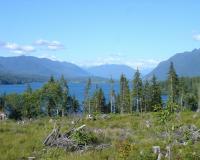
Vibrant Environment
Climate Change And Sustainability
All | Biodiversity | Climate Change and Sustainability | Environmental Justice | Governance and Rule of Law | Land Use and Natural Resources | Oceans and Coasts | Pollution Control

The Biden Administration recently finalized the first phase of a two-part rulemaking process to reverse some of the Trump Administration’s revisions to CEQ rules for implementing NEPA. In mid-April, ELI hosted a panel to discuss how these new rules might alter federal agency reviews of climate change and environmental justice impacts.

Just over a half-century ago, Diet for a Small Planet, Frances Moore Lappé’s surprise best seller, exposed the harms of animal agriculture to a wide audience in the same way that Rachel Carson’s book of a decade earlier, Silent Spring, put to widespread shame the practice of applying pesticides to cropland. The title of Moore Lappé’s book encapsulates her thesis. The math in 1971 made a compelling case that abandoning meat is indeed necessary to avoid crossing planetary boundaries.

Rice is a primary food source for more than half of the world’s population—especially in Asia, Africa, and Latin America. In China, the rice-consuming culture I’m most familiar with, rice is breakfast, lunch, dinner, and dessert. Even the Chinese character for “cooked rice” simultaneously means “food.” Rice is security, sustenance, and life itself.

Tribal nations have been leading the way in climate change adaptation planning long before local governments even got started.

According to a 2020 report published in Nature, up to 20 percent of the global carbon budget could be consumed by construction over the next 30 years.

I encountered an induction cooktop for the first time recently, and my life has never been the same. Boiling water, which usually bores me to tears, took half as much time as it did on a gas stove. Garlic sizzled in seconds; broccoli softened in a minute or two. With a press of the on button, I sped up time itself, whizzing through a recipe that would take me an hour on a traditional electric stove, 45 minutes on a gas cooktop.

The COVID-19 pandemic has exposed and exacerbated inequities that lead to differences in health outcomes, particularly for racial and ethnic minority groups. One community that has been particularly affected is the Pacific Islander community in the United States, which has experienced exceedingly high rates of infection, hospitalization, and morbidity.


For the last several decades, many leading businesses have expressed support for climate policy in the United States. While there are many businesses that expressed concerns and even advocated for policies back into the late 1990s, here I will trace efforts back to 2006. That was the year the U.S. Climate Action Partnership (USCAP) was initiated. The USCAP was a collaboration between leading businesses and climate-focused NGOs. Its goal was to develop consensus policy recommendations and principles for Congress and the new executive administration that would be elected in 2008.

The climate emergency is here, and the only way to stop the downward slide to chaos is to cut methane and other super climate pollutants as fast as possible, while also dramatically reducing carbon dioxide emissions. One message has been made clear by the United Nations Environment Programme and Climate and Clean Air Coalition’s Global Methane Assessment, and the IPCC’s Sixth Assessment reports: Cut methane now or doom the planet.